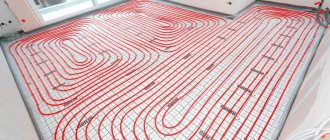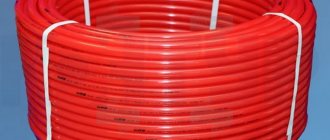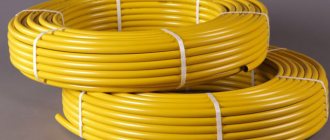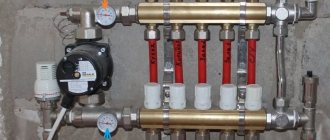Home » Equipment » Warm floor
A water underfloor heating system requires a boiler with a heat exchanger in which the coolant is heated. Hot water from the boiler enters the main line, which is located on the floor. Passing through the water circuit, the coolant cools down and returns again to the heat exchanger.
Galvanized, copper and plastic pipes that can withstand high temperatures are used for the main line. The water leaving the boiler has a temperature of 80 0C.
For underfloor heating, it is recommended to use PEX lines made of cross-linked polyethylene. They have unique characteristics. They are easy to lay on the subfloor. What features do PEX pipes have? How to install a water main?
Which pipes are best to use?
For floor lines, only those circuits that can withstand high temperatures are suitable.
Today on the market there is a variety of products made from the following materials: copper, metal-plastic, cross-linked polyethylene. Separately, we will talk about galvanized pipe materials.
Each type has its own characteristics and is intended for use in specific conditions.
PEX pipes made of cross-linked polyethylene
Pipes made of cross-linked polyethylene have excellent performance characteristics, which give them an undeniable advantage over other materials, and are therefore popular both for cold water supply and for installation in heated floor structures.
The material for their manufacture is polyethylene with a certain density. Stitching of products is carried out using several methods.
Depending on the production process, the pipeline is of different classes:
- PEX-a - high-density polyethylene is used in production. The production method is peroxide, which involves melting polyethylene under high temperature. After which, the resulting amorphous mixture is squeezed out through a special forming hole, this method is called extrusion.
PEX-a is a multi-layer construction, with an aluminum insert placed between the layers, which helps maintain the shape of the product. A special glue is used to connect the layers; it does not change its properties under the influence of temperature.
For your information! The product is capable of transmitting oxygen to the coolant. To eliminate penetration, manufacturers began to equip it with an EVOH protective coating on the outside - this is a layer of thin plastic (polyvinylethylene).
- PEX-b - for its production, medium-density polyethylene is taken, which is softened to a solid consistency. With this method, crosslinking is done after extrusion.
- PEX-c - the raw material in this case is also medium-density polyethylene. Crosslinking is carried out at a temperature equal to the environment, while the state of the material is solid.
Hoses made of cross-linked polyethylene are widely used in the installation of heated floors, but PEX-a is more often used, as they have good elasticity and allow laying a line with a bend of up to 5 diameters.
PEX-b is harder and therefore breaks easily. And PEX-c does not tolerate high temperatures well, and therefore is more often used for cold water. In addition, products made from this material are durable and lightweight, which is a plus when installing it yourself.
PEX-a pipes have memory - when deformed, they are able to completely restore their shape; for this they need to be heated. PEX-b does not have such properties, while PEX-c has this property reduced.
Polyethylene PE-RT
PE-RT pipes are modified; they differ from PEX in the absence of seams. A system made from such tubes is practically silent and withstands sub-zero temperatures, but although it tolerates high positive temperatures well, it does not last long.
In addition, this material is susceptible to the action of aggressive substances, and there is no structural memory. But, despite this, heat-resistant polyethylene is widely used in heated floors, as it has a reasonable price.
Metal-plastic
A metal-plastic pipe for underfloor heating is an excellent option. It is flexible and plastic, and can be bent even without heating. In addition, the material is durable, tolerates temperature changes well and is environmentally friendly.
The metal-plastic pipeline consists of several layers - cross-linked polyethylene inside, then metallized foil, and a polymer coating on the outside, which protects against mechanical damage. In this design, corrosion does not form and scale deposits do not occur. If installed correctly, the pipeline will last more than 50 years.
If we compare which is better - metal-plastic or cross-linked polyethylene for heated floors, we can note the high thermal conductivity of plastic. But at the same time, there is a high risk of the coil breaking, and since such a product does not have the ability to restore its shape, this section will have to be removed.
Metal
Metal pipes for warm water floors are available in the following types:
- Copper ones have a high cost, so they are not very popular when installing hydrofloors. In addition, laying such a pipeline is not easy; special equipment is required, and it is unlikely that it will be possible to install it yourself.
However, it is worth noting that a copper pipe is an ideal option for heated floors, as it has excellent characteristics:
- high thermal conductivity;
- durability;
- not susceptible to corrosion;
- ductility and strength.
- Stainless steel corrugated steel is a relatively new type that is well suited for heated floors, but due to its high price it is not used often. The product has a protective polymer coating, and the stainless metal is not subject to corrosion and is resistant to mechanical, chemical and temperature influences.
In addition, this model has increased flexibility; installation in the most complex patterns is possible, without the risk of creasing.
To summarize , we can say that the most popular models that are used for heated floors are a metal-plastic pipe or a cross-linked polyethylene pipe .
They have good performance characteristics and are affordable. But if financial resources allow, then it is better to use a metal (copper) pipeline; it has high thermal conductivity and durability.
How is the main line installed?
For water underfloor heating you will need a flat subfloor surface. It is recommended to use a screed, self-leveling floor, or use a self-leveling mixture. The water pipeline is laid on a dry surface. It is recommended to use insulating materials so that all the heat from the water circuit is directed to the floor.
- The base is covered with a thin plastic film.
- I'm laying insulation. It is recommended to use a contour coating made of polystyrene foam "Rehau". The PEX underfloor heating pipe fits well into the contour of the coating. The highway is laid in a “snake” or “snail” pattern, outlining the protruding contours of the bosses. They crimp the pipe from the sides, securely fixing it in a certain place.
- The main is connected to a collector, which has an outlet for hot and chilled water. Connect the entire system to the heating boiler. Testing the heating system.
- The heated floor with PEX pipes is poured with a concrete screed up to 8 cm deep.
We recommend: How to repair underfloor heating?
Foam boards are used as insulation for the subfloor. Foil material is placed on the plates. This is a reflective screen that will direct the heat upward. To strengthen the highway, reinforced mesh and mounting brackets are used.
The staples are installed on the mesh with a certain pitch. They are made of plastic and have teeth pointing down. The teeth will not allow the water circuit to change position or exit the groove.
PEX pipes are used not only for underfloor heating, but also for cold and hot water supply. No corrosion or salt deposits form on the inner surface of the product, which prolongs the service life of the water circuit.
When heated, cross-linked polyethylene PEX does not emit toxic substances. The products are used in pharmaceutical enterprises. Cross-linked polyethylene for PEX-a and PEX-c is included in the group of environmentally friendly products.
YouTube responded with an error: The request cannot be completed because you have exceeded your quota.
- Related Posts
- How to calculate the length of a heated floor?
- How is the mesh for underfloor heating installed?
- How to install Grand Meyer underfloor heating?
- Is it possible to lay laminate flooring on a heated floor?
- What myths exist about the dangers of heated floors?
- How to install electric heated floors under tiles?
Is it possible to connect underfloor heating pipes or not?
When laying a pipeline for a heated floor, often the length of the circuit is not enough to make a solid loop. In this case, the question arises: is it possible to connect the pipes to each other, and how to do this? There are several methods for connecting contours, which depend on the type of material.
Important! When choosing a method to join floor pipes, you should take into account the operating pressure, since each connection is designed to withstand a certain load.
Let's take a closer look at the methods of how to connect underfloor heating pipes.
Connection of cross-linked polyethylene and metal-plastic pipes
Mini-review: how to install fittings?
Contours made of polyethylene or metal-plastic can be sewn together using fittings (brass, bronze and plastic); they can withstand high temperatures. Fittings are:
- Electric welding ones are effective, but their installation requires special equipment, so they are rarely used. The process looks like this:
- An electric welding fitting is placed on the pipe cut;
- welding equipment is connected to the terminals, it will supply voltage to the element, which will lead to heating and fusion of the joints;
- the device turns off, the resulting connection can withstand pressure up to 12 Amp.
- Pressing - the main advantage is that when pressing, the entire space is filled with polymer, thereby creating a high-strength connection.
Sequencing:
- A nut is placed on the edge of the crimp tube, with the thread facing the connection;
- the split ring is put on with an indentation of 1 cm from the cut and fixed;
- the hose with the fitting device is stretched;
- The crimp nut is tightened tightly using two wrenches.
- Crimp fittings - these fittings are the easiest to install at home:
- a clamping sleeve is placed on the polymer hose;
- the end of the contour is stretched in diameter using an expander;
- with the stretched edge, the tube is pulled all the way onto the fitting fitting;
- the connection point is fixed in this position for several minutes, this is enough for the fitting to be tightly spliced.
Copper pipe stitching
Just as when installing a plastic circuit, copper can be joined using press or push fittings. This method is recommended in open areas, so that in case of leakage the part can be easily changed.
But the most reliable and practical way is to solder copper pipes. This is a more labor-intensive process, but the connection is durable and reliable. Sequencing:
- contour sections are cleaned from the outside and inside;
- a special connector for soldering copper floor heating pipes is used to lubricate the edges of the parts - only from the top;
- the products are joined, and the excess mixture is removed;
- the joint is heated with a gas burner and solder fills the gaps.
How to connect underfloor heating pipes (press fitting)
As mentioned above, the pipeline can be joined using press fittings. This part consists of:
- housings - come in different shapes (angle, tee, coupling);
- sleeves are the basis of the fitting, the raw material for its production is stainless steel;
- clips - an elastic ring (gasket) that connects the body and the sleeve.
For your information! The fitting body is equipped with a “window” to control the correct insertion of the tubular product. Only when the tube is visible in this hole can you begin pressing.
Pressing is carried out using special press jaws. The essence of the procedure is to compress the handles of the tool. The process is quick and easy, and no special skills are required to carry out this work.
The advantage of using such a connection is strength, long service life and the design does not require maintenance.
Connection methods
There are several ways to connect parts of the pipeline during installation:
- compression (crimp) fittings;
- compression fittings;
- electric welded fittings.
The choice of a specific connection type depends on the planned operating characteristics.
To install communications, you may need the following tools:
- Special pipe cutter-scissors. A pipe cutter allows you to cut pipes into sections of the desired size without applying excessive effort. In this case, the cut will be smooth, without burrs, at an angle of 90 degrees. Such a cut will ensure high quality and reliability of the future joint.
- Hydraulic Press.
- Collet expander for increasing the diameter of the pipe before inserting the fitting.
- Pliers.
- Wrenches for tightening the crimp nut.
- Fitting.
Connection of underfloor heating pipes in a screed
Although experts advise laying a water-heated floor under a screed without joints, it is not prohibited to do so.
But it is worth noting that it is impossible to connect the floor contours using a threaded method: “American” or PRH. It is better if the pipes are connected using a press fitting or coupling.
Important! When filling such areas with screed, fittings or couplings should be isolated from the concrete solution. This can be done by wrapping them in plastic film.
Preparing the base
When building a house, you can literally immediately organize the correct heating system, but when installing a heated floor in a living space, it is important to consider this issue from preparing the foundation:
- You need to understand that the entire floor consists of several layers. First of all, waterproofing is provided, which will protect the ceiling from leaks. This stage is especially important in multi-storey buildings;
- then the insulation is laid, it will not heat the slab, the heat should go up, so it is important to use polystyrene foam or special foam substrates;
- Next, pipes are laid through which hot water will flow, which heats the entire floor. The pipes used are metal-plastic;
- on top of the work you need to make a screed, the thickness of which reaches 8.5 cm;
- Considering that all laid layers significantly raise the floor, you can use some tricks when preparing the floor;
- you can knock down the old screed to the very base, but you must take into account that the work is hard and there will be a lot of dust and debris;
- if the floors are laid in your own home, then you can go deep into the ground as much as necessary;
- if polystyrene foam is used as insulation, it takes up a lot of space, you can replace it with foil backings, for example, penofol;
- professionals often reduce the thickness of the screed, this gives them the opportunity to save 6 cm in height;
- sometimes a heated floor system is used using a special substrate; glue can be applied to it and tiles can be installed. In this case, neither waterproofing nor thermal insulation will be required;
- You can choose a dry underfloor heating system, when a special heat-insulating base is placed, and metal plates are placed in the grooves, they distribute heat evenly over the entire surface.
How to solder a heated floor pipe
Soldering is a common method of connecting plastic pipes for underfloor heating. The technology is simple and does not require large financial investments. There are two soldering techniques:
- Coupling - for this, a shaped part is used (coupling or contour with a large diameter). This method is suitable for tubes measuring 63 mm. The welding process consists of melting the edge of the product on the outside and part of the coupling on the inside. After which, the parts are joined, forming a tight connection.
- Direct - involves melting small sections of two plastic pipes, which are then joined at the ends. This fairly simple method reliably combines two parts into a single outline.
For your information! Along with hot technologies, the method of “cold” soldering is practiced. A special solvent is used that softens the plastic.
How to connect a heated floor pipe with a metal-plastic pipe
Although experts recommend using a pipeline made of one material when installing a heated floor, sometimes it becomes necessary to connect a metal-plastic circuit with products made from other raw materials.
For example, when connecting this circuit to steel (copper) parts of the plumbing or heating system. To do this, you will need a compression fitting and a calibrator. When joining products made of different materials, the thread should be selected according to the size of the steel pipe, and the cuffs and washers should be selected according to the metal-plastic pipeline.
Tow is wound onto the copper pipe, and then the fitting is screwed on. The edge of the product is pushed onto the cone and the nut is tightened.
If it is necessary to connect a metal-plastic circuit with polyethylene products, special threaded fittings can be used as a connector for underfloor heating pipes. This joint is most often made when connecting a heated floor to a boiler.
Floor testing and pressure testing
Before pouring the floor with concrete screed, it is necessary to test and pressure test the water circuit.
The finished heating system is tested as follows:
- the pipeline is filled with hot water;
- for approximately 30 minutes the temperature in the system rises to critical (80ºС - 85ºС).
The final stage of checking the system is pressure testing (high pressure test). For this:
- the pipeline system is filled with cold water;
- all air extractors located in the manifold are turned off;
- The pressure is set at 6 bar for 24 hours.
Checking pipes for leaks and high pressure
If, at the end of the pressure test, no excessive expansion or deformation of the pipes is noticed, and the set pressure has not decreased, then the resulting water circuit is completely sealed and suitable for use.
What to do if a heated floor pipe is broken?
If there are warm water floors in a house or apartment, there are times when the floor pipeline may be broken. First of all, if the floor is functioning, you should disconnect it from the water supply. But more often, such damage occurs during installation or repair of the system, when the topcoat is not laid and the screed is not poured - this is a huge plus.
If there is a concrete screed, in order to find the location of the damage, you will need a hammer drill, a chisel and a hammer to destroy the concrete. This should be done carefully so as not to damage the entire circuit.
What to do if the floor heating pipe is damaged. Repair of "warm floor". Installation of press fitting.
When pipes made of metal-plastic or polyethylene are pierced, they are repaired using press couplings using a special press.
For your information! If the heating element is filled with screed after repair, then the use of threaded fittings is not possible.
Having calculated the location of the breakdown, you should remove the damaged area and install a whole circuit in its place. The connection is made using press couplings, which should be wrapped in plastic film to protect them from cement mortar.
Water heating circuit
Let's look at the water heating diagram for the place where we will install the heated floor.
The batteries in the kitchen are powered by a supply circuit that runs along the perimeter of the second floor. The battery output is sent to the so-called return circuit, which is installed in the basement. We will connect the heated floor to the second output of the battery and direct it to the return circuit.
To turn off the battery and the heated floor, install taps 1 and 2, respectively.
Additionally, we will install a circulation pump at the entrance to the return circuit. This is how we implement all the requirements of the owners.
Is it possible to extend pipes if they are not long enough?
As you know, it is better to make a loop of a warm water floor than a solid one, this gives the system reliability, and connections are made at the points of attachment with the collector. If the heated room is large, it is recommended to divide the area into several branches.
In order not to make a mistake in the size of the loop, you should make the calculation correctly. To do this, you can use an online calculator.
However, if necessary, it is still possible to lengthen the contour of the heated floor by connecting the missing section of pipe to it, which, by the way, is allowed according to GOST. It is possible to extend heated floor loops using various methods; for this, butt joints are used, most often press fittings.
For your information! In such cases, it is recommended to use pipelines and fittings from the same manufacturer.
To summarize, we can say that connecting underfloor heating pipes is acceptable, and there are various ways. But it is more practical and reliable to lay a single loop, especially under the screed, so that in case of leakage you do not have to destroy the concrete layer.
In addition, preference should be given to high-quality pipe products and connecting parts from trusted manufacturers. In such cases, the heating floor will serve you for a long time and will create a comfortable atmosphere in the house.
System operating modes
Let's consider the system as a whole and determine its operating modes. In natural circulation mode, the coolant moves directly through the red pipe of the water floor into the return circuit. Both taps are open at this moment. If you turn off the top tap, the coolant from the heated floor pipe will move through the additional pipe towards the pump. In this case, the pump must be turned on. This is a mode for quickly warming up a heated floor.
In order not to disturb the natural circulation in the general heating circuit in the fast heating mode, we can slightly open the second tap. Thus, part of the flow will be reversed. For circulation pumps with precise speed control, this problem can be solved using a mode switch.
Let's close the bottom tap. The pump must be turned off. In this mode, the radiator circuit in the kitchen and the heated floor are completely blocked. If we turn off only the warm floor, then circulation from the battery is carried out along the primary circuit through the return pipe.
This circulation pump model has three power selection modes. For the purposes of our system, we will need the most minimal mode. Its power consumption is 30 W. When the connection to the return circuit is completed, the system is filled with coolant.
For this private house, a system pressure of 1.5 - 2 atmospheres is used. Within the next 24 hours after filling, it is necessary to check the system for leaks and eliminate leaks.
All rights to the video belong to: DoHow
Heated floors are a worthy alternative to standard radiator heating, as they not only allow you to save on utility bills, but also achieve uniform heat distribution in the room. Laying a pipe for a heated floor is the most critical process when installing a heating system, however, all work can be carried out without the involvement of professionals.
Making a heated floor with your own hands
After the calculations, the floor installation is carried out in several stages:
- surface preparation for installation of a heating system;
- pipe layout and connection to the collector;
- system check;
- filling the floor.
Scheme of the finished structure











